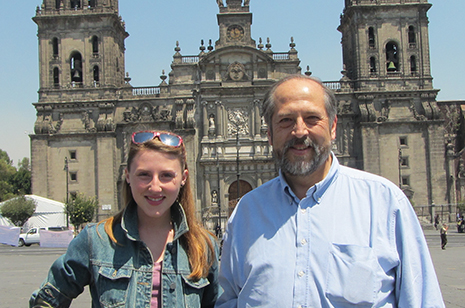Drought Contributed to Typhus Epidemics in Mexico from 1655 to 1918, Study Shows

Jordan Burns and Rodolfo Acuna at the Zocalo, the central square in the heart of historic downtown Mexico City.
FAYETTEVILLE, Ark. – Epidemiological data integrated with climate data taken from tree-ring estimates of soil moisture levels demonstrate that drought contributed to the spread of typhus in Mexico from 1655 to 1918, according to a new study by researchers at the University of Arkansas.
The study has modern-day policy implications because although typhus can be treated with modern antibiotics, it remains a threat in remote, impoverished areas of South America, Asia and Africa and could reemerge as a serious infectious disease, especially where social strife and underdeveloped public health programs persist.
The researchers describe their findings in an article published Feb. 11 in Emerging Infectious Diseases, a Centers for Disease Control and Prevention journal that tracks and analyzes disease trends.
“Historical records show that typhus has traditionally accompanied war, famine and poverty,” said David Stahle, a Distinguished Professor of geosciences. “Now, because of Mexico’s rich historical record of epidemic disease, we can see that drought, as reconstructed by tree-ring chronologies, caused conditions that allowed typhus to flourish in central Mexico over a 250-year period.”
Stahle and Jordan Burns, a graduate student in geography at the U of A, compared historical records of 22 typhus epidemics in central Mexico with soil moisture estimates based on tree-ring reconstructions. They analyzed data gleaned from almanacs, diaries and personal accounts, as well as medical and death records from hospitals, physicians, cemeteries and municipalities. They compared this with instrumental data for the Palmer Drought Severity Index, or PDSI, an index of the effects of temperature and precipitation on soil moisture dating back to 1895.
Burns, Stahle, and their collaborator Rodolfo Acuna, a professor of microbiology at the National University in Mexico City, observed a significant relationship between periods of drought and famine in rural, agricultural regions of central Mexico. Below-average tree growth, drought and low crop yields occurred during 19 of the 22 typhus epidemics.
“The observed relationship between drought and typhus epidemics in colonial and modern Mexico is curious because drought has not been specifically considered a risk factor for typhus,” Burns said. “But drought, much like war and natural disasters, caused famine in poor, agricultural regions and forced impoverished refugees to move into already crowded urban areas where infrastructure and sanitary systems were insufficient.”
Epidemic typhus is an infectious disease caused by a bacterium transmitted between people by body lice. The disease spreads where conditions are crowded and unsanitary. It is recognized for its high mortality rate throughout human history, particularly before modern sanitary practices and the availability of antimicrobial drugs. Despite these advances, the disease persists in some areas of Africa, South America and Asia and has not been eliminated from industrialized regions, because body lice infestation still occurs in homeless populations of Europe and the United States.
For more than 30 years, Stahle has taken core samples from trees and examined the chronology of their rings to help explain the societal impact of drought and other climate changes. Specifically, his research has added rich information to explanations about the migration of North America’s indigenous people and the demise of Mesoamerican civilization.
Stahle’s recently published 1,238-year-long tree-ring chronology, the longest and most accurate of its kind for Mesoamerica, was the first to reconstruct the climate of pre-colonial Mexico on an annual basis over a period of more than a thousand years. That study identified four ancient megadroughts and their exact years. Previous research found large and epic droughts in North America during the eighth and 16th centuries.
Topics
Contacts
Jordan Burns, research assistant, geosciences
J. William Fulbright College of Arts and Sciences
479-575-3703,
jnb001@uark.edu
David Stahle, Distinguished Professor, geosciences
J. William Fulbright College of Arts and Sciences
479-575-3703,
dstahle@uark.edu
Matt McGowan, science and research communications officer
University Relations
479-575-4246,
dmcgowa@uark.edu
Headlines
Four Students Named Goldwater Scholars; Two Earn Udall Honorable Mentions
Four U of A students have received the prestigious Goldwater Scholarship, an award for top students in mathematics, science, and engineering.
Cross-Campus Collaboration Culminates in New Outdoor Geological Installation
Grand opening event to celebrate the new GeoLab installation at the U of A’s Gearhart Hall courtyard is set for May 3. The installation will be open to the public year-round.
First Students to Use Online Degree to Hone Nursing Leadership, Elevate Patient Care
Hanna Baxendale and Wendi Kimbrell will begin coursework in the Doctor of Nursing Practice-Executive Master of Business Administration program offered by the Eleanor Mann School of Nursing and Walton College.
Join the Office for Sustainability on a Final Cruise to Campus
Cruise to Campus Wednesdays have fostered a gathering space for individuals interested in biking to campus. Drop by the Old Main Lawn from 7:30-10 a.m. Wednesday for coffee, something to eat and conversation.
Fay Jones School Student Ambassador Program Gives Voice to Design Students
The student ambassador program at the Fay Jones School of Architecture and Design is built to connect top design students with their school, its alumni, its future students and others inside and outside the school.




